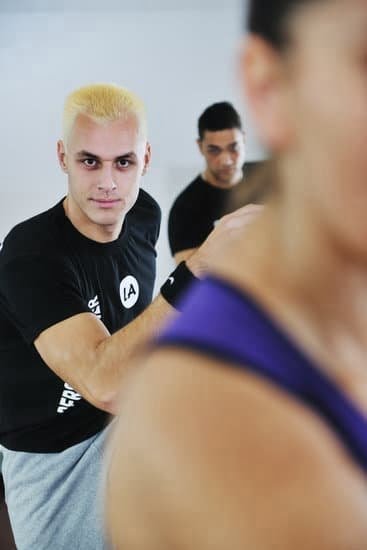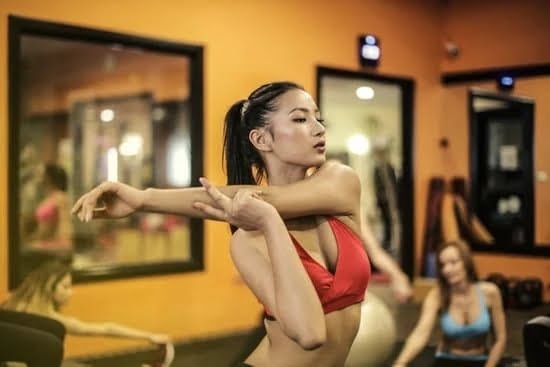Introduction
Mixed Martial Arts (also known as MMA) is a hybrid sport combining elements of striking, wrestling, and jujitsu. It has grown in popularity over the past few decades and has become one of the most popular martial arts disciplines. It offers practitioners a great way to stay in shape, build self-confidence, learn effective self-defense techniques, and compete with others in a safe environment.
So, how can an average person train MMA? Regardless of age, size or fitness background there are several steps that any person can take to begin training MMA.
1. Find a Qualified Instructor: The first step in beginning an MMA training program is finding an experienced instructor who favors good training over quick technique that may not be practical in real world scenarios.
2. Physically Prepare: Most MMA training activities require physical endurance such as running, jumping rope and pushing weighted objects. Therefore it is important for anyone looking to train to establish physical limits and improvements through cardio conditioning and strength building exercises like sprinting, pushups and weightlifting drills on a regular basis prior to starting any technical aspects of MMA training for competition or self defense purposes.
3.Develop Striking Skills: Learning how to strike effectively is critical in the success of any MMA practitioner Therefore researching and practicing proper contact techniques are essential while also learning frequently utilized combinations between strikes so they can be implemented quickly when necessary. This practice should begin with light contact bag work with protective gear such as headgear, gloves and mouthpieces before moving on to situational sparring with different opponents replicating moments in competitive bouts or actual combat situations respectively.
4.Learn Grappling Tactics: A strong ground game is also important when it comes to mixed martial arts which will require developing skills in stand-up grappling maneuvers where the fighters clinch at close range like taken down defense, reversal positions during the scramble for dominant control about those bouts usually end within moments after the wrestler secures dominance from their opponent by either submitting them with joint locks chokes or just holding their opponent down utilizing their body weight until minutes pass without contestable move initiated from the other participant signaling submission victory for theirs fighter
Breaking Down the Basics of MMA
MMA (Mixed Martial Arts) is one of the fastest growing sports in the world. It involves different disciplines such as kickboxing, Jiu Jitsu and wrestling, which require a high level of physical conditioning. You don’t have to be an elite athlete to compete in MMA; anyone with a passion and drive can train themselves to become a successful martial artist.
To train MMA, it’s important to develop both your physical conditioning and fighting techniques. There are several ways that an average person can take on MMA training. First, it’s important to focus on developing your physical strength and endurance through cardio workouts such as running or swimming, as well as strength-training exercises like lifting weights or Pilates. Additionally, introducing dynamic stretching into your fitness routine will help enhance your performance by increasing mobility and flexibility.
When it comes to learning martial arts techniques for MMA, many people choose to take classes at a gym or a local martial arts dojo. However, there are also plenty of online resources available that offer instructional videos on techniques like strikes and submission holds that you can practice at home. Whether you take group classes or follow online tutorials, regularly practicing techniques with proper form will help you develop your skillset over time.
In addition to honing your technique and physical conditioning, nutrition plays an important role in optimizing performance for MMA athletes. It’s important for aspiring fighters to maintain good eating habits and stay hydrated throughout the day. Eating healthy meals that are designed for optimal muscle growth and recovery is essential for maximizing performance within an intense training program like MMA training.
Establishing a Solid MMA Foundational Practice
Anyone with a passion for martial arts can become an MMA fighter, but it takes dedication, hard work and determination to reach your full potential. For the average person who wants to train MMA, there are a few key steps you can take to establish a solid foundation in mixed martial arts.
The first step is to start building physical strength and endurance through proper weight training and cardio. Working out will provide you with the muscular power needed to move quickly around the ring or octagon while also preparing your body for contact. You should also focus on core stability exercises which will help you maintain good form during grappling and striking.
The second step is to develop the psychological edge of combat. Learning how to stay calm under pressure and developing mental fortitude is just as important as physical strength in a bout. Visualization techniques can be beneficial for seeing yourself make smart decisions when in the cage or ring.
Thereafter, it’s time to begin mastering specific skills such as striking, wrestling, submission grappling and so on from experienced trainers or coaches—especially focusing on technique over power when first getting started. Technique is key in martial arts, so don’t rush this one – train slowly and steadily until you have each skill set down pat before progressing onto more difficult moves or maneuvers. Lastly, building up sparring experience with both stand up drills as well as light contact sparring (in addition to drilling) will prepare you like nothing else for competition once ready!
Identifying, Understanding and Applying MMA Techniques
MMA can be a great way for the average person to improve their physical condition, confidence and self-defense skills. Training MMA requires commitment—practicing proper technique, honing one’s speed and reflexes, and building strength and endurance.
The first step in learning MMA is to understand the fundamentals. This includes knowing the basic striking techniques (punches, kicks, knees) and grappling techniques (takedowns, submissions). Many experienced MMA coaches suggest that new students watch fight videos so they can get a better grasp of how these techniques are applied in a live setting. Reading books on the specifics of fight disciplines or taking online classes or videos is another great resource for acquiring knowledge.
Practice is key to mastering the techniques taught in class. After understanding the basics with an instructor, the student must now practice those moves repeatedly in order to build muscle memory. Proper form must be emphasized from the start to ensure that bad habits do not form as one progresses in training. A jump rope and various conditioning exercises like push-ups and burpees are also essential to an MMA training regimen; finding a sparring partner to practice with is essential for more advanced practitioners . Striking bags, pads and mitts provide valuable feedback about accuracy, power, timing and speed; wrestling dummies are another helpful tool for developing takedowns and ground control skills.
Furthermore, students must maintain focus on their nutrition; this includes proper hydration during practices as well as choosing the right meals before sessions or fights make sure your body has enough fuel to go on long rounds without tiring out too quickly. Adequate rest is also paramount—avoid overtraining so muscles can regenerate between sessions or fights.
Creating and Maintaining an Effective Training Routine
Creating a well-rounded and effective MMA training routine is essential to success in the sport. An average person should consider focusing their routine on either traditional martial arts such as kickboxing and Muay Thai, or jiu-jitsu and wrestling. It is important to vary drills and exercises to ensure a full-body workout as well as maximize skill development in multiple aspects of MMA. Traditional martial arts should include a combination of striking, movement, clinch work and basic take downs – with focus being given to the fundamentals before progressing into more advanced techniques. At least three days per week in should spent practicing Jiu-Jitsu and strategies such as sweeps, submissions and guard passing should be drilled before any sparring sessions. Additionally, two days per week can be dedicated towards building strength, power, speed and endurance. Training with experienced coaches at a professional gym for both striking arts and grappling are highly recommended for those just starting out in MMA; however some basic practice and research can be done by an average person on their own in order to develop familiarization with the sport. Finally, an average person who wants to train MMA should be dedicated and have discipline when following through with any kind of set program – it will take time and patience but overall they can expect improved balance, coordination, physical stability and better self-defense skills if they stick with it.
Working On Progress and Staying Injury Free
An average person can train MMA safely and effectively by following a few simple steps. First, find a qualified coach or instructor to help teach the basics of MMA. This will help ensure proper form and technique for learning the various martial arts disciplines that make up MMA. Next, start off with light sparring to get used to fighting without getting seriously injured. Gradually add on more advanced techniques as your skills improve. A good way to work on progress is to set achievable goals and strive for them each week or month. Work on your strength and conditioning program both in the gym and at home so you are prepared for any challenge inside the ring. Lastly, listen to your body and stay injury free to prevent losing training time due to injury setbacks. A good proportion of rest-to-training time can help keep your body fresh while still pushing it further each session. Incorporate stretching before a workout and implement dynamic warmups prior to sparring or bagwork in order to prepare muscles for action. All this combined will ensure you can become a proficient student of Mixed Martial Arts with no major injuries along the way!
Preparing For Long-Term Success With MMA
MMA is one of the fastest-growing sports, and attracting more and more people each year. It can be challenging to learn all the martial arts, fighting techniques, and maneuvers needed to become an effective mixed martial artist. As with any sport, it takes time, dedication and years of practice to gain mastery over the skills associated with MMA. An average person may find it overwhelming at first but there are some simple steps that can help them get started on the journey.
First, having a good foundation of knowledge is essential for long-term success in MMA. This includes learning about basic physiology (how muscles and nerves work together) as well as nutrition and fitness principles. It is also important to be well-rounded in your training by practicing multiple disciplines such as Kickboxing, Jiu Jitsu, Sambo or Wrestling etc in order to gain a better understanding of how each style works together and against another during a fight.
Second, having strong physical attributes will contribute to being an excellent fighter. Exercising regularly with weights should be part of your routine along with focused conditioning drills that are specific to MMA such as grappling dummies and agility ladders. You should also ensure you have adequate rest between sessions so that you are not pushing yourself too hard or too fast too soon which could lead to injury or burnout over time.
Finally, having discipline is paramount for becoming a successful mixed martial artist since competition requires intense focus both physically and mentally during bouts; this requires special motivation that comes from within as well as a strong desire to beat opponents no matter what odds they might be facing off against you while in the cage or on the mats. A disciplined approach will put yourself in a position where you push through limits you thought were impossible before while also preparing yourself for how unpredictable matches can be in MMA competitions; this goes both ways however so never forget to stay humble even when winning!
Tailoring Your Training for Your Unique Goals
When it comes to training MMA, there is no one-size-fits-all approach. Each person’s individual experience and physical condition will differ greatly when it comes to determining what kind of MMA training program should be followed. It is important for an average person to build a training program that is tailored to their own unique goals and abilities.
There are several variables to consider when developing a training regimen for MMA. First and foremost, it is important to focus on developing a strong foundation of physical fitness by working on the basics such as cardiovascular exercises, strength training, flexibility drills and core exercises. Once this level of conditioning has been established, a fighter can then look into more specific combat-style conditioning such as pad work or drilling with opponents. Along with physical skills and conditioning regimes, mental preparation should also be included in the overall training plan. This can include visualizing fights or competing under pressure and different strategies that could be used while in the ring or cage.
In addition to mastering technical skill sets, many average people in MMA find that including nutrition education into their plan helps them reach their goals quicker. There are numerous resources available online that can help those interested in learning more about nutrition for athletes and ways to create a healthy balanced diet for optimal performance results.
Ultimately it depends on the individual’s goals in regards to how lengthy or detailed their training program should be; however, following these basic guidelines will put them well on their way towards success as an average person learning how to train MMA properly!
Conclusion
The average person can train MMA by dedicating time and energy to their training. This typically involves using basic MMA movements and combinations, along with specific drills, grappling, kickboxing and a variety of other disciplines. All of these areas should be mastered in order to be able to properly compete in an MMA bout or fight. Additionally, the individual should also focus on developing skills such as conditioning, strength and flexibility training which are essential for success in this type of combat sport. As an average person embarks on the journey of MMA training they will develop many physical and mental qualities that will prove invaluable for them later in life regardless of if they decide to compete or not.
It does take significant dedication and commitment from an individual to become a competent MMA competitor, but the rewards far outweigh the challenges faced. Through becoming proficient at Mixed Martial Arts one person can develop confidence, self-discipline and gain a greater understanding of their own capabilities; all benefits that can aid them throughout their lives. Furthermore, the accomplishment that comes with competing is something that may go unmatched when compared with any other challenge. From learning various martial arts techniques to developing mental fortitude—the positives associated with training MMA are numerous and well worth an average person dedicating their time striving towards excellence in this sport.

Passionate about providing useful information to anyone with an interest in the field of Personal Training, I strive to pass on to our readers quality information and to answer any questions about Personal Trainers, the work they do and how to become one.





